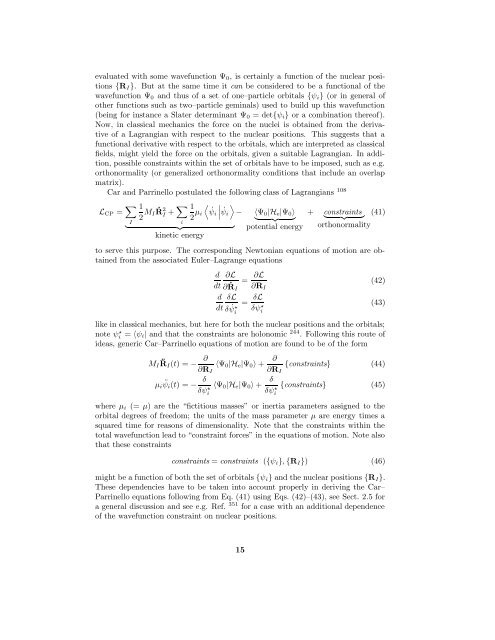Ab initio molecular dynamics: Theory and Implementation
Ab initio molecular dynamics: Theory and Implementation
Ab initio molecular dynamics: Theory and Implementation
- No tags were found...
Create successful ePaper yourself
Turn your PDF publications into a flip-book with our unique Google optimized e-Paper software.
evaluated with some wavefunction Ψ 0 , is certainly a function of the nuclear positions{R I }. But at the same time it can be considered to be a functional of thewavefunction Ψ 0 <strong>and</strong> thus of a set of one–particle orbitals {ψ i } (or in general ofother functions such as two–particle geminals) used to build up this wavefunction(being for instance a Slater determinant Ψ 0 = det{ψ i } or a combination thereof).Now, in classical mechanics the force on the nuclei is obtained from the derivativeof a Lagrangian with respect to the nuclear positions. This suggests that afunctional derivative with respect to the orbitals, which are interpreted as classicalfields, might yield the force on the orbitals, given a suitable Lagrangian. In addition,possible constraints within the set of orbitals have to be imposed, such as e.g.orthonormality (or generalized orthonormality conditions that include an overlapmatrix).Car <strong>and</strong> Parrinello postulated the following class of Lagrangians 108L CP = ∑ 12 MIṘ2 I + ∑ 1〈 ∣ 〉 ∣∣2 µ i ˙ψ i ˙ψ i − 〈Ψ 0 |H e |Ψ 0 〉} {{ }Ii} {{ } potential energykinetic energy+ constraints} {{ }(41)orthonormalityto serve this purpose. The corresponding Newtonian equations of motion are obtainedfrom the associated Euler–Lagrange equationsd ∂L= ∂Ldt ∂Ṙ I∂R I(42)d δLdt δ ˙ψ= δLi⋆ δψi⋆ (43)like in classical mechanics, but here for both the nuclear positions <strong>and</strong> the orbitals;note ψ ⋆ i = 〈ψ i| <strong>and</strong> that the constraints are holonomic 244 . Following this route ofideas, generic Car–Parrinello equations of motion are found to be of the formM I ¨R I (t) = −∂ 〈Ψ 0 |H e |Ψ 0 〉 +∂ {constraints} (44)∂R I ∂R Iµ i ¨ψi (t) = − δδψ ⋆ i〈Ψ 0 |H e |Ψ 0 〉 + δδψ ⋆ i{constraints} (45)where µ i (= µ) are the “fictitious masses” or inertia parameters assigned to theorbital degrees of freedom; the units of the mass parameter µ are energy times asquared time for reasons of dimensionality. Note that the constraints within thetotal wavefunction lead to “constraint forces” in the equations of motion. Note alsothat these constraintsconstraints = constraints ({ψ i }, {R I }) (46)might be a function of both the set of orbitals {ψ i } <strong>and</strong> the nuclear positions {R I }.These dependencies have to be taken into account properly in deriving the Car–Parrinello equations following from Eq. (41) using Eqs. (42)–(43), see Sect. 2.5 fora general discussion <strong>and</strong> see e.g. Ref. 351 for a case with an additional dependenceof the wavefunction constraint on nuclear positions.15









